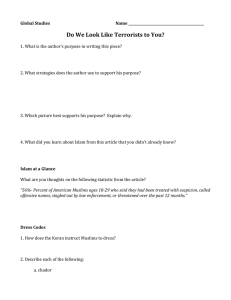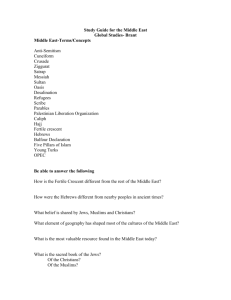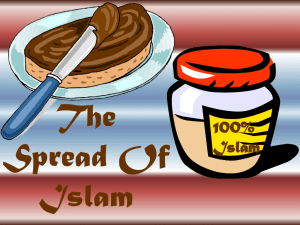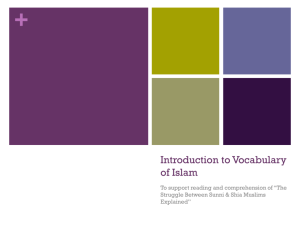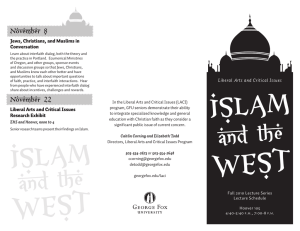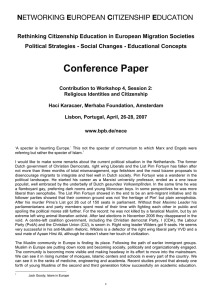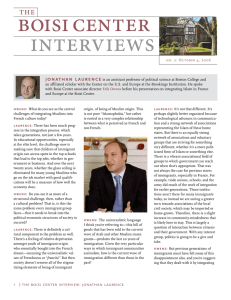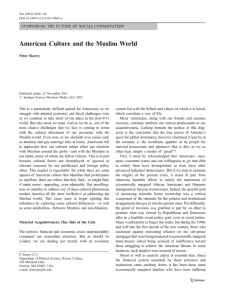Middle East Culture and Society
advertisement
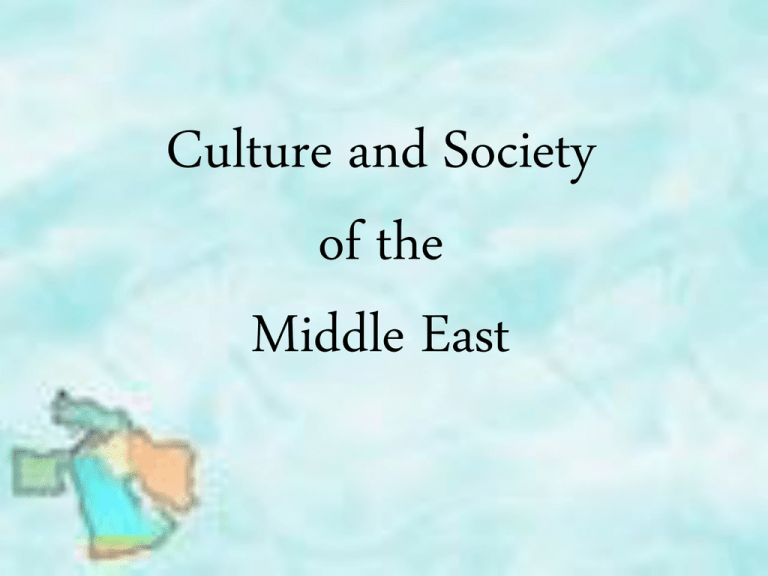
Culture and Society of the Middle East Religion • Religion plays a big role in Middle Eastern society • Religion is considered one of the main pillars of society and individuals are stereotyped based on their religion Dominant Religions of the Middle East 1. Islam (Sunni and Shia) 2. Judaism 3. Christianity During Muslim holidays or Ramadan, life is affected by ceremonies and everyone is expected to respect those ceremonies while in public. Office hours and business dynamics change in many Middle Eastern countries during the month of Ramadan. It’s highly recommended that one belongs to a formal religion when in this part of the world as well as avoiding engaging in a religion-based discussion or analysis. Such an interaction can immediately lead to animosity or distance. The best attitude to have is to just be a listener and a learner when it comes to religious conversations. To illustrate how religions are used to identify and organize society, religions and religious sects in Lebanon have been assigned quotas for job openings, and high level positions in the government are required to be filled by certain religious followers. For example, in Lebanon the president must be a Maronite Christian, the prime minister must be a Sunni Muslim, the minister of foreign affairs is usually an Orthodox Christian, etc. In other countries in the Arab world, Christians are not authorized to hold many key positions. - Berich Consulting, LCC • Islam is viewed by many Muslims not simply as a religion, but also as a cultural identity and heritage • The tension is between modernity and tradition (struggle between Islam and western modernity) Muslims on pilgrimage to Mecca Govt. and Politics • Politics affect culture in the Middle East • Factors which influence politics are: - Civic - Tribal - Religious Common forms of govt. in the Middle East: - Theocracy (Iran) - Monarchy (Saudi Arabia) - Republic (Syria) - Democracy (Iraq) Languages • Arabic is the dominant language • Other common languages: - Hebrew - English - French - Turkish - Kurdish Role of the Family • Basic family unit: - Extended family - Nuclear Family • Role of Family: - Loyalty and Obligation (Values) - Refuge and Support System - Children are Taught Respect for Adults Status of Women • Women’s status vary depending on the country. - Turkey, Lebanon, Syria, Jordan, and Egypt, educated women have been very active at all levels of society - Persian Gulf States, most women do not work and they stay at home • Traditionally-oriented men and women don’t see prevailing customs as restrictions-rather as protections - “Modern influence and Muslim feminism” Values • Honor (self-respect to self-pride) and expectation of equal treatment regardless of wealth, position, or rank. • Strong loyalty to extended family, friends, and locality, and a great expectation of solidarity. Norms • Sense of Independence and Resentment of imposed rules or decisions not sanctioned by social norms and customs (others cultures). • Hospitality to Guests and Visitors. • No Public Displays of Affection!! Food • Middle Eastern Food refers to the cuisine of the various countries and peoples of the Middle East, North Africa, & Western Asia. Common Foods: - Hummus (made from chickpeas) * Muslims do not drink alcohol - Baba Ghanoush (eggplant) or eat pork (Non-Muslims do) - Fatayer (meat pie) - Labneh (strained yougurt) - Lamb (primary meat) - Figs, Dates, Nuts - Falafel, Keftes, Kofta - Pita Bread Baba Ghanoush Labneh w/Hummus Fatayer Falafel Dining Etiquette • • • • • Conversations are animated and loud. “Breaking bread” is an important event in any relationship building. The head of the family or honored guest is normally served first. The eldest person has priority in being served food. For Muslims, the left hand is reserved for bodily hygiene and considered unclean. Thus, the right hand should be used for eating; shaking hands or handing over an item with one's left hand is an insult. • If invited to a restaurant the host is usually pays Dress Code Male Dress: - Thawb (robe with long sleeves) - Bisht (cloak worn over Thawb) - Keffiyeh (traditional headress) - Westen Style clothes (suits, t-shirts, jeans, slacks) Dress Code Female Dress: - Abaya (large black cloak covering the entire body) - Hijab (headscarf that conceals hair and forehead) - Niqab (veil that covers the face) - Burqa (veil that covers the entire body) - Westen Style clothes (suits, slacks) Change & Influence • Present day Middle East is a mix of very old cultures and new nations which were organized by European powers after WWI • Most countries in the Middle East maintain a great deal of cultural influence and economic ties with western nations and a powerful Islamic culture! Nations which influence Middle East culture, economics, and politics: 1. France 2. Great Britain 3. The United States 4. Russia Traditional City Narrow Allies, Plain External Design Traditional City • • • • Privacy Open space is located within the traditional house. All Houses look alike form outside – no decoration. Court yard is located inside the house. Traditional City ▲ Umayyad Mosque built 705-715 AD. ◄ Suq (Shopping Mall) Al-Hamiddiyyah. Modern City “Multi-Story apartment buildings is the new residential pattern.” Dubai, U.A.E. Modern Dubai Cairo, Egypt
